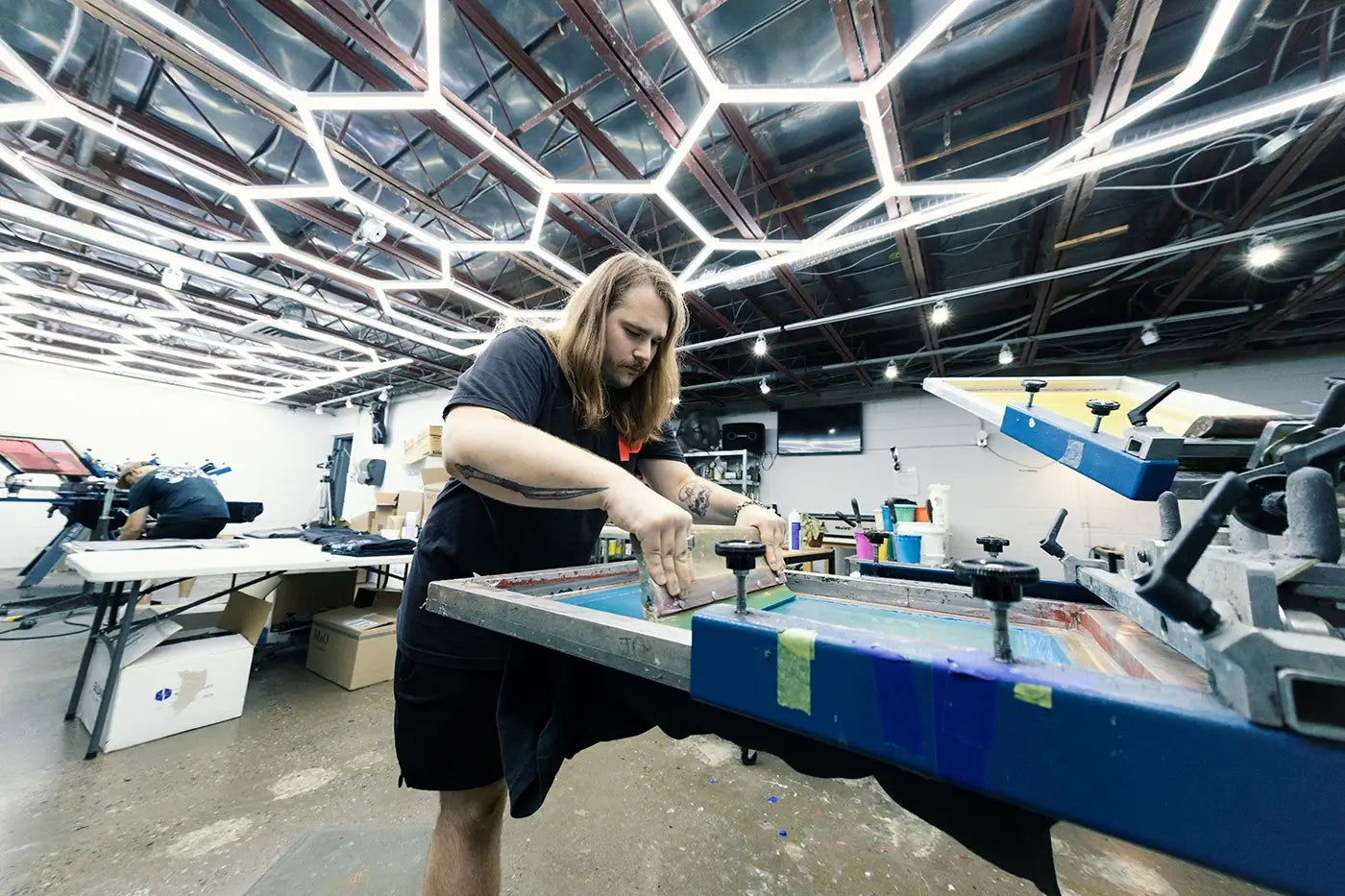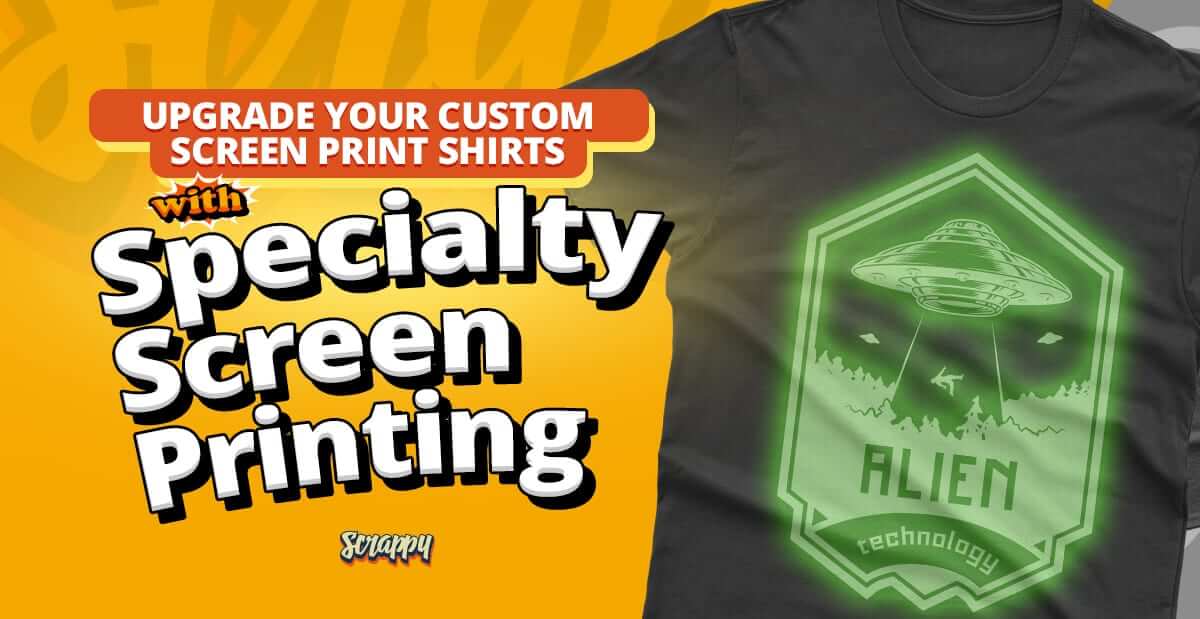Screen Printing Uncovered: Everything You Need to Learn About Tee Shirt and Garment Printing Strategies
If you've ever before wondered exactly how those vivid styles finish up on your preferred t-shirts, you remain in the appropriate location. Display printing is a remarkable method that combines art with strategy, supplying endless possibilities for imagination. Recognizing the basics, from equipment to ink options, can significantly affect your outcomes. All set to explore the essential elements that make display publishing an art type? Allow's discover the details that can elevate your jobs.
The Fundamentals of Display Printing: Just How It Functions
When you dive into display printing, you'll find it's both a scientific research and an art. At its core, display printing entails producing a pattern, or display, that permits ink to pass via only in details locations.
Following, you'll mix your inks and prepare your printing surface area. Setting the screen over the fabric, after that use a squeegee to press ink with the display onto the garment. This process needs precision, as you want clear, vibrant prints. After printing, you'll heal the ink with warmth, ensuring it sticks to the fabric and lasts with washes. Each step is vital, and mastering them will raise your screen printing abilities, transforming easy garments into distinct, meaningful items.
Kinds Of Screen Printing Methods
As soon as you grasp the basics of screen printing, it's time to explore the different methods that can raise your styles. One popular approach is conventional screen printing, where ink is pushed via a stenciled screen.
If you're going for fine details, consider discharge printing. This strategy eliminates dye from the fabric, leaving a soft, classic look. An additional alternative is plastisol printing, recognized for its sturdiness and brilliant shades, making it a favorite for many brand names. Experiment with halftone printing to create slope impacts and intricate layouts. Each method has its special appeal, so do not think twice to try them out to locate what fits your design best!
Essential Equipment for Display Printing
To accomplish stunning lead to display printing, having the appropriate devices is fundamental. You'll require a sturdy screen printing structure, which holds the mesh that transfers your layout onto the garment. Next, buy top notch squeegees; these are crucial for applying ink evenly throughout the display. You'll also need an excellent direct exposure system to develop your screens, in addition to a washout cubicle for cleaning them after usage. A trustworthy heat source, like a conveyor dryer or warmth press, is crucial for treating your prints to ensure longevity. Do not neglect a correct office, equipped with tables and storage for your materials. Ultimately, protective equipment, such as masks and handwear covers, will keep you secure from chemicals and inks. With the right devices, you'll be well on your way to producing professional-quality prints.
Picking the Right Inks and Products
When picking inks and products for screen printing, you need to take into consideration the kind of ink that functions finest for your job. Consider textile compatibility to assure your styles look last and terrific long. Also, discover environment-friendly ink alternatives to make your printing procedure a lot more sustainable.
Kinds Of Screen Inks
Picking the appropriate display ink is crucial for achieving vibrant, resilient prints that fulfill your project's needs. There are a number of kinds of screen inks to examine. Plastisol ink is popular for its versatility and convenience of usage, offering excellent shade opacity on dark materials. Water-based ink, on the various other hand, supplies a softer feel and is environmentally friendly, making it perfect for those wanting to minimize their ecological effect. Release inks eliminate dye from the fabric, leading to a soft, vintage appearance but require specific handling. Lastly, specialty inks, such as metal or glow-in-the-dark, can include special effects to your styles. Examine your task demands and pick the ink that straightens best with your wanted outcome.

Material Compatibility Factors To Consider
Understanding textile compatibility is important for accomplishing top notch display prints, particularly considering that different products respond distinctively to different inks. When choosing inks, think about the material type-- cotton, polyester, or blends. For cotton, water-based inks work well, offering softness and breathability. Polyester, on the various other hand, often requires plastisol inks for better attachment and lively colors. If you're publishing on blends, you could need to use a mix of both kinds. Always evaluate your inks on sample textile to ensure they adhere appropriately and maintain shade stability. In addition, maintain in mind that fabric weight and texture can influence the final outcome, so selecting the appropriate ink and material combination is vital for your task's success.
Eco-Friendly Ink Options
Green inks are ending up being a popular selection for display printers that wish to decrease their environmental effect while keeping top quality. When selecting inks, consider water-based inks, which are much less dangerous and less complicated to clean up contrasted to conventional solvents. These inks bond well with textiles, supplying vibrant outcomes without toxic chemicals. You might likewise explore eco-solvent inks that use fewer unpredictable natural substances (VOCs), making them a more secure choice for both your health and wellness and the planet.
Furthermore, look for inks made from renewable energies, such as soy or vegetable-based alternatives. By choosing the right inks and products, you'll not just develop spectacular layouts yet likewise contribute to a more sustainable printing process. Make the button, and your prints will reflect your commitment to the environment!
Preparing Your Layout for Display Printing

Submit Format Needs
To ensure your layout looks vibrant and sharp on fabric, you'll require to pay close attention to file format demands for screen printing. Beginning with vector documents like AI or EPS, as they can be scaled without losing high quality. If you utilize raster images, select high-resolution documents, such as TIFF or PNG, preferably at 300 DPI. Prevent utilizing JPEGs, as they can lose clearness when resized. Also, ensure your style has a clear history to avoid undesirable white sides on your prints. Maintain shade settings in mind; CMYK is basic for display printing, so transform your RGB makes appropriately - screen printing kit. By adhering to these guidelines, you'll establish your art work up for a successful print.
Shade Separation Techniques
Color separation is a vital action in preparing your layout for display printing, and mastering it can substantially improve your print quality. You'll require to damage your style into individual shades, as each shade calls for a separate screen throughout printing. This precision not only ensures precise shade representation yet additionally simplifies the printing procedure.
Resolution and Dimension
Attaining the very best results in screen printing begins with guaranteeing your style has the right resolution and size. Preferably, your artwork needs to go to the very least 300 DPI (dots per inch) for sharp, clear prints. If you use reduced resolution, your final product could look less than professional and pixelated.
When it pertains to size, consider the dimensions of your print location. Layout your art work to match the final print dimension, ideally producing it in the real measurements you'll be printing. In this manner, you'll stay clear of any kind of unforeseen scaling problems.
Constantly examine your design in both vector and raster layouts. Vector graphics can be scaled without losing high quality, making them perfect for display printing. Preparing appropriately will ensure your layout looks fantastic on every garment!
Step-by-Step Display Printing Refine
Display printing is a vibrant process that enables you to create dynamic styles on numerous surfaces. To obtain started, you'll require a screen, emulsion, and your chosen ink.
After washing out the unexposed emulsion, your screen prepares. Set it up on your printing surface and straighten your garment under it. Pour ink onto the display and make use of a squeegee to press the pop over to this site ink through the stencil onto the material. Raise the screen meticulously and allow the print dry. Ultimately, heal the ink making use of warmth to ensure durability. That's it! You have actually efficiently display published your design.
Tips for Successful Display Printing Projects
While you're diving right into your screen printing projects, keep in mind that prep work is crucial to success. Start by collecting all your products-- inks, garments, squeegees, and displays. A clean work area helps protect against undesirable mistakes, so neat up prior to you start.
Next, confirm your artwork is high-resolution and effectively sized for your garment. Examine your screen for correct direct exposure and tidy it extensively to avoid spots. When mixing your inks, adhere to the maker's guidelines to attain the appropriate uniformity.
Throughout printing, apply also pressure with your squeegee for constant outcomes. Don't hurry; take your time to validate each print meets your criteria. After printing, let your garments completely dry completely before handling or packaging them.
Finally, constantly maintain a sample of your benefit future referral. By doing this, you can evaluate your progression and enhance your strategies over time. Delighted printing!

Regularly Asked Inquiries
How much time Does It Require To Set up a Screen Printing Job?
Setting up a display printing job commonly takes around thirty minutes to an hour. You'll prepare the displays, mix inks, and change the press. The time varies based upon intricacy and experience, so remain arranged!
Can I Publish on Various Material Enters Using the Same Technique?
Yes, you can print on different textile kinds utilizing the same strategy, yet you'll require to change your inks and settings. Some textiles take in ink differently, so exploring guarantees the most effective results for every product.
What Prevail Blunders to Avoid in Display Printing?
When screen printing, stay clear of typical errors like utilizing the incorrect ink, ignoring proper direct exposure times, or avoiding pre-press checks. Always examine your configuration and maintain tidy displays to ensure best site quality outcomes each time.
How Can I Effectively Clean and Preserve My Display Printing Tools?
To appropriately clean and preserve your screen printing tools, you must consistently wash displays with proper solvents, inspect squeegees for wear, and assure all tools are saved dry and dust-free. Consistency protects against pricey repair services and enhances performance.
Is Display Printing Ecologically Pleasant Contrasted to Various Other Methods?
Display printing can be much more eco-friendly than other techniques, particularly if you use eco-conscious products and water-based inks. By choosing sustainable materials and techniques, you minimize waste and reduce your impact on the earth.
Display Printing Uncovered: Whatever You Required to Know About T-Shirt and Garment Printing Methods
At its core, display printing includes developing a stencil, or display, that permits ink to pass with just in specific locations. Position the screen over the textile, then utilize a squeegee to press ink through the display onto the garment. One popular technique is traditional screen printing, where ink is pushed through a stenciled screen.When choosing inks and materials for screen printing, you require to take right into account the kind of ink that works best for your project.